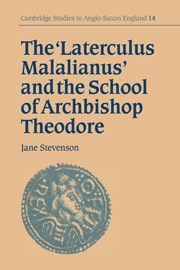Book contents
- Frontmatter
- Contents
- Preface
- List of abbreviations
- 1 Introduction
- 2 The contents of the Laterculus
- 3 Date and origin of the Laterculus
- 4 The nature of the Laterculus
- 5 Sources of the Laterculus
- 6 The Latinity of the Laterculus
- 7 Translational technique of the Laterculus
- 8 Manuscripts
- 9 Conclusion
- Text and Translation
- Commentary
- Appendix: Variant and anomalous biblical texts
- Bibliography
- Index of biblical sources
- General Index
1 - Introduction
Published online by Cambridge University Press: 20 March 2010
- Frontmatter
- Contents
- Preface
- List of abbreviations
- 1 Introduction
- 2 The contents of the Laterculus
- 3 Date and origin of the Laterculus
- 4 The nature of the Laterculus
- 5 Sources of the Laterculus
- 6 The Latinity of the Laterculus
- 7 Translational technique of the Laterculus
- 8 Manuscripts
- 9 Conclusion
- Text and Translation
- Commentary
- Appendix: Variant and anomalous biblical texts
- Bibliography
- Index of biblical sources
- General Index
Summary
At the end of the last century, Mommsen edited a series of Chronica Minora in the Monumenta Germaniae Historica. These included a chronicle which he called Laterculus Malalianus, which covers the historical period of the gospels, and is based in part on the work of John Malalas, author of a sixth-century Byzantine world-chronicle. The word laterculus in Classical Latin means ‘a brick’, or ‘a tile’ or something of the sort, but in the early Middle Ages it came to mean a list, sometimes a computus (a table for calculating the date of Easter), and is often used as equivalent to fasti. Mommsen grouped several imperial lists together in Chronica Minora, and used laterculus as the generic name for them. So my text is defined, superficially, as an imperial list – a definition which I should say here and now is almost entirely irrelevant to it. The classification of Laterculus Malalianus is based on a very minor aspect of the text, which is that it ends with a list of Roman emperors, from Augustus to Justin II. The second half of the title, Malalianus, simply means ‘connected with John Malalas’.
The Laterculus has always been categorized as a chronicle-text, its name linking it specifically with the chronography of the consular lists, or of the calculation of Easter. And, of course, it is based in part on the Chronographia of Malalas. But some two-thirds of its length is completely independent of Malalas, and although its Malalian structure is a correlation of the gospels and Roman imperial history, its independent content is basically exegetical.
- Type
- Chapter
- Information
- Publisher: Cambridge University PressPrint publication year: 1995

